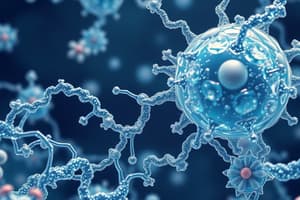Podcast
Questions and Answers
What percentage of our body weight is made up of water?
What percentage of our body weight is made up of water?
Water makes up 2/3 of our body weight.
Why is water referred to as the universal solvent?
Why is water referred to as the universal solvent?
Water is called the universal solvent due to its ability to dissolve many organic and inorganic compounds.
What is meant by the term 'high heat capacity' in relation to water?
What is meant by the term 'high heat capacity' in relation to water?
High heat capacity refers to water's ability to absorb and retain heat, allowing it to remain liquid over a wide range of temperatures.
Explain the role of water in chemical reactions within the body.
Explain the role of water in chemical reactions within the body.
What defines a solution, and what is its relation to water?
What defines a solution, and what is its relation to water?
What are the seven major functions of proteins?
What are the seven major functions of proteins?
Describe the structure of an amino acid.
Describe the structure of an amino acid.
What happens to ionic compounds like sodium chloride when they are dissolved in water?
What happens to ionic compounds like sodium chloride when they are dissolved in water?
What process forms a peptide bond between amino acids?
What process forms a peptide bond between amino acids?
Define hydrophilic molecules and give an example.
Define hydrophilic molecules and give an example.
List and briefly describe the four levels of protein structure.
List and briefly describe the four levels of protein structure.
Why is maintaining the concentration of electrolytes in body fluids important?
Why is maintaining the concentration of electrolytes in body fluids important?
What indicates a double covalent bond between atoms?
What indicates a double covalent bond between atoms?
How do nonpolar covalent bonds differ from polar covalent bonds?
How do nonpolar covalent bonds differ from polar covalent bonds?
How does the shape of a protein relate to its function?
How does the shape of a protein relate to its function?
What is a characteristic of water that contributes to its ability to dissolve ionic compounds?
What is a characteristic of water that contributes to its ability to dissolve ionic compounds?
What roles do enzymes play in cells?
What roles do enzymes play in cells?
What is the primary function of nucleic acids?
What is the primary function of nucleic acids?
What role do hydrogen bonds play in the properties of water?
What role do hydrogen bonds play in the properties of water?
Define the terms 'reactants' and 'products' in a chemical reaction.
Define the terms 'reactants' and 'products' in a chemical reaction.
Why are proteins considered pivotal in biological systems?
Why are proteins considered pivotal in biological systems?
What happens to energy during chemical reactions?
What happens to energy during chemical reactions?
What type of energy is associated with molecular bonds?
What type of energy is associated with molecular bonds?
How does the concept of energy conservation apply to chemical reactions?
How does the concept of energy conservation apply to chemical reactions?
What characterizes hydrophobic molecules and provide an example of such a molecule.
What characterizes hydrophobic molecules and provide an example of such a molecule.
Describe the relationship between hydrogen ion concentration and pH.
Describe the relationship between hydrogen ion concentration and pH.
What does a pH of 7.0 indicate about a solution?
What does a pH of 7.0 indicate about a solution?
What are acids and how do they affect pH in body fluids?
What are acids and how do they affect pH in body fluids?
Explain the concept of alkalosis and its cause.
Explain the concept of alkalosis and its cause.
What ions affect the acidity of solutions and why?
What ions affect the acidity of solutions and why?
What is the role of hydrogen ions (H+) in physiological processes?
What is the role of hydrogen ions (H+) in physiological processes?
What happens to cells and tissues when there is an excess of hydrogen ions in the body?
What happens to cells and tissues when there is an excess of hydrogen ions in the body?
What distinguishes saturated fatty acids from unsaturated fatty acids?
What distinguishes saturated fatty acids from unsaturated fatty acids?
What roles do triglycerides play in the human body?
What roles do triglycerides play in the human body?
Identify two functions of steroids within the body.
Identify two functions of steroids within the body.
How do phospholipids contribute to cell membrane structure?
How do phospholipids contribute to cell membrane structure?
What are eicosanoids, and from which acid are they derived?
What are eicosanoids, and from which acid are they derived?
Differentiate between monoglycerides and diglycerides.
Differentiate between monoglycerides and diglycerides.
Why are proteins considered the most important class of molecules in the human body?
Why are proteins considered the most important class of molecules in the human body?
What is the significance of the number of double bonds in fatty acid chains?
What is the significance of the number of double bonds in fatty acid chains?
Flashcards are hidden until you start studying
Study Notes
Chemical Bonds and Reactions
- A double covalent bond shares 2 electron pairs, indicated by a double line (==).
- Carbon dioxide (CO2) contains two double covalent bonds.
- Nonpolar covalent bonds feature equal electron sharing, like in oxygen (O2), leading to symmetrical shapes.
- Polar covalent bonds occur with unequal electron sharing, as seen in water (H2O), creating a dipole with partial positive and negative charges.
- Hydrogen bonds are weak attractions between polar molecules, crucial for the structure of proteins and DNA.
- Water's hydrogen bonds contribute to surface tension, affecting interactions with particles.
- Reactants are substances that enter a chemical reaction; products are the outcomes, with metabolism encompassing all biological reactions.
Water and Its Properties
- Water comprises approximately two-thirds of body weight and is vital for chemical and physiological processes.
- Unique properties of water arise from its polarity and hydrogen bonding:
- Solubility: Water is a universal solvent, making it capable of dissolving many organic and inorganic substances.
- Reactivity: Most bodily reactions either utilize water or occur in aqueous solutions.
- High heat capacity: Water maintains a liquid state across various temperatures due to its capacity to absorb heat.
- Lubrication: Minimal friction between water molecules promotes smooth interactions.
- Electrolytes, such as NaCl, dissociate in water and are essential for physiological functions.
- Hydrophilic compounds readily dissolve in water, while hydrophobic substances, like fats, do not.
pH and Body Regulation
- The concentration of hydrogen ions (H+) in solutions is measured using the pH scale; higher H+ concentrations indicate acidic conditions (pH < 7), while lower concentrations indicate basic conditions (pH > 7).
- Pure water has a neutral pH (7.0).
- Acids release H+ ions, lowering pH, whereas bases remove H+ ions, raising pH.
- Body fluid pH must be carefully regulated to prevent acidosis (excessive acidity) or alkalosis (excessive alkalinity).
Lipids
- Five main classes of lipids exist:
- Fatty acids consist of carbon chains and vary by saturation levels: saturated (no double bonds), monounsaturated (one double bond), and polyunsaturated (multiple double bonds).
- Eicosanoids derive from arachidonic acid, affecting injury and hormone regulation.
- Glycerides include monoglycerides, diglycerides, and triglycerides, serving as energy sources and insulation.
- Steroids feature four carbon rings, with cholesterol found in cell membranes and various hormones.
- Phospholipids and glycolipids create cell membranes with hydrophilic heads and hydrophobic tails.
Proteins
- Proteins, composed of carbon, hydrogen, oxygen, and nitrogen, are critical for all bodily functions.
- Functions of proteins include:
- Support through structural proteins.
- Movement via contractile proteins.
- Transport through transport proteins.
- Buffers for pH regulation.
- Metabolic regulation by enzymes.
- Coordination and control through hormones.
- Defense as antibodies.
- Proteins consist of amino acids, each containing a central carbon, hydrogen, an amino group, a carboxylic acid group, and a variable side chain (R group).
- Peptide bonds form between amino acids, creating polypeptides that fold into specific shapes essential for function.
- The four levels of protein structure include primary, secondary, tertiary, and quaternary structures.
Nucleic Acids
- Nucleic acids are large organic molecules made of carbon, hydrogen, oxygen, nitrogen, and phosphorus, responsible for storing and processing molecular information.
Studying That Suits You
Use AI to generate personalized quizzes and flashcards to suit your learning preferences.




